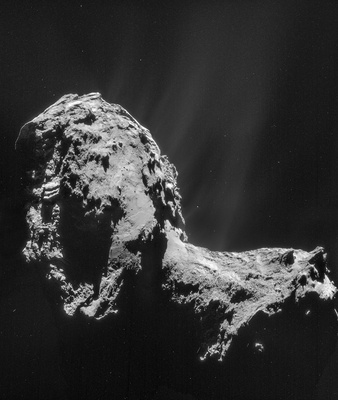CometWatch 20 November - In the shadow of the coma
Due to rotation and translation of the comet during the image taking sequence, making a mosaic involves some compromises, as features change slightly from one image to the next. In addition, scattering in the NAVCAM optics can lead to large-scale intensity artefacts which are difficult to cater for when mosaicing.
Thus, for this set of NAVCAM images, some pre-mosaicing masking and post-mosaicing localised intensity adjustments have been made to reduce the low-level artefacts. By their very nature, these adjustments are not perfect.
The image shows vast outflows of gas and dust, as well as smaller ‘jets’ stemming from the neck and the larger lobe of the comet, suggesting increased levels of activity since rendezvous in August.
Post-processing in LightRoom was also used to bring out the faint outflows, while retaining the brighter features on the comet. Exceptionally, an increased exposure and contrast version of the mosaic is also provided to give an even better view of the outflowing material.
![]()
Same as the mosaic above, with increased exposure and contrast. Credits: ESA/Rosetta/NAVCAM – CC BY-SA IGO 3.0
In particular, at the bottom of the mosaic, the non-illuminated part of the comet stands out as a silhouette against the broader diffuse emission coming from the comet's coma. There are hints of a diffuse 'atmosphere' close to the surface of the comet seen along the illuminated edges, but this could be due to scattering in the NAVCAM optics. The large number of small white blobs in the image are likely specks of dust or other small objects in the vicinity of the comet.
